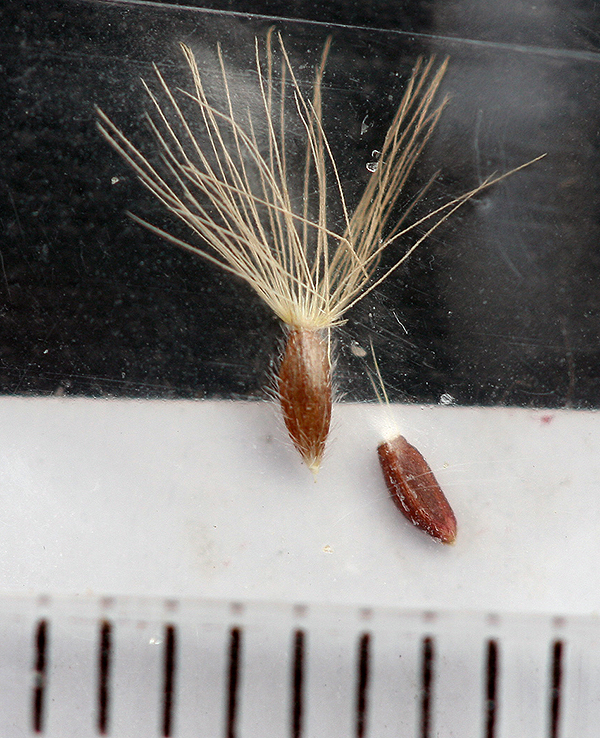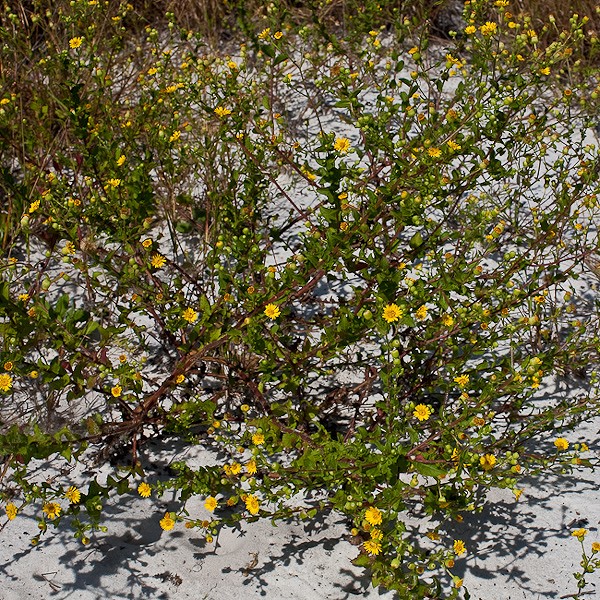Heterotheca subaxillaris
Golden-Aster, Camphor Weed
Asteraceae
This blazing 90 degree morning John and George* investigated red widow spiders, pine tree tip dieback, loblolly bay in fancy bloom, and mosses in Seabranch State Park near Stuart, Florida. We botanize there often.
Feral hogs have stirred up patches of soil, with a consequence I always find interesting: pokeweed babies rising from the disturbed earth. Pokeweeds are known for their heterocarpy, that is, differential circumstances for distribution and germination within a single species. Many plants make mixed offspring in terms of how far the seeds or fruits will travel, or with seeds having mixed germination requirements and timing. Reportedly in pokeweed some seeds are prone to sprout soon after release. Other sleep in the earth for decades until some hog stirs things up, even in a deep shaded woods unfit for pokeweed residence. Some time ago in this blog we covered sea rocket, where half the fruit remains on the mother plant while the other half breaks free to go colonize new beaches.
The heterocarpic flower in pretty bloom this week is named for its hetercarpy: Heterotheca means “different containers,” in reference to its two types of fruits. Sometimes called Golden-Asters, Heterotheca subaxillaris is a common local bright sunny yellow-flowered weed on bright sunny dry sands. This species has extreme tolerance for drought and heat. Heterothecas (grandiflora) are so tough they have become invasive pests on Mars-like volcanic lava fields in Hawaii.
The leaves are fuzzy and smelly, giving today’s plant the name camphor-weed. I like the fragrance, but how many people know what camphor smells like, or even what it is? I just Googled camphor so I arrogantly know much about it for the next hour or two. Fact is, Heterotheca is a one-plant chemistry lab with a wide array of pharmaceuticals. The “family” of fragrances Heterotheca brings to mind are wormwood, marigolds, and sunflower leaves. (They are all related, and the similarity may come from lactone sesquiterpenes, but who cares?)
The obvious function of the stinky, sticky, chemical-laden, glandular hairy covering is to deter herbivory. Nothing would want to crawl upon or eat camphor-weeds! And there may be a secondary advantage to the hairs—protection from sun and drying. Look at the death valley habitat in the photo above. Plant hairs insulate the leaf surfaces from drying wind, and they block sun, maybe even reflecting solar radiation. I don’t know if this is true of Heterotheca, but some botanists have suggested that glandular hairs might make a “sunscreen” that can spread and protect the foliar surfaces. Even better, in other fuzzy species of similar habitats the hairs produce water-retentive compounds to create a moisturizing gel when the rains come. It would be fun to look into some of this in Heterotheca which is so hairy and so oddly happy in a solar oven. The structure of the hairs helps define the genus. A mutant hairless Heterotheca would probably wither unprotected.
As for the heterocarpy, in a flower head, most of the “seeds” (achenes) have parachutes to blow away to colonize a distant disturbed sand pit. Some of the seeds, however, have no parachute, and recolonize their home neighborhood.

Heterotheca achenes showing heterocarpy: one has a parachute; one is bare. One flies far away; one keeps the home fires burning.
*Sorta let the blog slide. Lost my mojo when our awesome international blog friend Mary Hart passed away in the U.K. But John and George have kept up the botany—John has been working on the Seabranch site linked above, with some help from George. And George has been developing a companion site to an introductory botany course, with a lot of John’s photos.


theshrubqueen
June 20, 2015 at 10:24 pm
Great to see you guys back!
George Rogers
June 20, 2015 at 10:33 pm
what a nice comment to find!
Steve
June 22, 2015 at 9:45 am
Welcome back George and John.
mossyglen
June 20, 2015 at 10:27 pm
Glad you’re back! You’ve been missed!
George Rogers
June 21, 2015 at 10:33 am
Well, now we must keep coming up with adaptations and weirdness. John is expanding his photo-interests into video, so might have to link in some footage, if all the creatures cooperate. Starting with red widow spiders.
Mark
June 21, 2015 at 12:12 am
“George has been developing a companion site to an introductory botany course, with a lot of John’s photos.”
And what address can that be found?
George Rogers
June 21, 2015 at 10:35 am
it is at http://www.botanycompanion.wordpress.com. The site is a companion to PBSC’s intro botany class extbook, but I put all those hours into it hoping it’ll see some use beyond the college…
sdingwell
June 21, 2015 at 6:52 am
Yes, I’ve missed you, too! Welcome back and keep it coming; always a breath of fresh air in addition to something interesting to learn. Thanks to you both for all the work; literary, botanical, philosophical and photographical.
George Rogers
June 21, 2015 at 10:37 am
Hi Susan! Thanks. Hope your great green summer is all going most excellently!
Sally Hart Brodie
June 21, 2015 at 7:07 am
I am breaking with personal tradition (and preference) to write this blog comment – I have so missed your blogs and was excited to read as soon as I saw email. As I have stated before, in emails, your blogs, and the online course, kept me sane/balanced during difficult work. The tilt of the scales has been moving to a dangerous direction, so here you are back, just in time! Thank you. And if it helps, my given name is Sally Hart. Oh, and by the way, being a Virginia girl, we know all about pokeweed. The young shoots were harvested and cooked for what we called ‘poke salad’. Somewhat akin to spinach.
George Rogers
June 21, 2015 at 10:48 am
Hi Sally, The mid south and Mason Dixon line seem to be the world’s headquarters for poke. I grew up mostly in W.Va. and the pokeweed in places there looks like small trees. Not only used for greens, but also for painting your face. (But bad idea—that juice is toxic, which I do not recall being a concern at age 10.) Half the reason I cling to local plants as a love and avocation is the therapeutic value of nature. Nothing reboots my brain and helps with stress and the blues more than an hour or two in the woods. It’s all so, well, ah, natural. I’ll bet way back sometime somehow you and Mary Hart are related. Confined to a wheelchair, she used her nature knowledge as a way to keep joy in the day. Hope your husband is still enjoying macrophotography. I’ve been suggesting to John he run a nature photography workshop…but it’s just too hot out now.
Martin
June 21, 2015 at 8:31 pm
Hello, brother George! It’s good to see you back.
George Rogers
June 21, 2015 at 8:43 pm
Yo Martin, Gotta get up to your forested habitat soon! How’d the eagles do this year?
Laure Hristov
June 25, 2015 at 8:49 am
So good to have you back writing, always enjoy your Blog. So very sorry to hear about your friend Mary😓. I enjoyed her comments and know she loved plants and the environment. Deepest sympathy!
Suellen Granberry-Hager
June 26, 2015 at 8:51 pm
I have missed the weekly posts, but I hope you enjoyed the break and the sabbatical from PBSC. I will be in the Intro Botany class this fall and appreciate your keeping the cost of the textbook down.
George Rogers
July 1, 2015 at 12:40 pm
Hi Suellen! Nice to hear from you. And even nicer to see you in the fall. Hope your many projects are all going great.